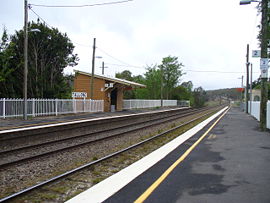Tallong, New South Wales
|
Tallong New South Wales |
|
|---|---|

Tallong Railway Station, which opened in 1869
|
|
| Coordinates | 34°43′0″S 150°05′0″E / 34.71667°S 150.08333°ECoordinates: 34°43′0″S 150°05′0″E / 34.71667°S 150.08333°E |
| Population | 715 (2011 census) |
| Postcode(s) | 2579 |
| Elevation | 448 m (1,470 ft) |
| Location | |
| LGA(s) | Goulburn-Mulwaree Council |
| Region | Southern Tablelands, Southern Highlands |
| State electorate(s) | Goulburn |
| Federal Division(s) | Hume |
Tallong is a village within the Southern Tablelands region of New South Wales, Australia, in Goulburn-Mulwaree Council. The village is located just outside the southern extremity of the Southern Highlands region and has some cultural and historic connections with this region also. In the 2011 census, the village had a population of 715. The town is 8.5 km from the town of Marulan and 25 km from the town of Bundanoon.
The principal industries of the village include stud farms, arts and crafts and services for surrounding farms.
Tallong is home to the Tallong Midge Orchid (Genoplesium plumosum), a tiny flower found only in the area surrounding the town. This orchid is now a protected species. It was discovered in 1997.
The original settlement was named Barber's Creek after the watercourse that runs through the town. In the early twentieth century the town was renamed "Tallong" after an Aboriginal word meaning either "tongue" or "spring of water".
The first European settler in the area was George Barber, a cattle farmer. In 1814 Barber established a cattle station along what became known as Barber's Creek. In 1821 he received a grant of 300 acres (120 ha) covering the general Tallong-Marulan district, to be converted from cedar brush to farmland. Before his death in a riding accident in 1844, Barber had extended his local landholdings to 4,000 acres (1,600 ha), which he named "Glenrock". He is buried in the Old Marulan Cemetery in Marulan.
In the late 1820s, that portion of Barber's land that would eventually become the township was sold or reallocated to Sydney entrepreneur and mariner Billy Blue. Convict labour was used to clear the grazing land and prepare a route for the Main South railway line to Goulburn. Tallong was selected as the location for a railway refuelling point, and the town's initial population consisted of convicts, woodcutters, railway workers and their families.
...
Wikipedia

